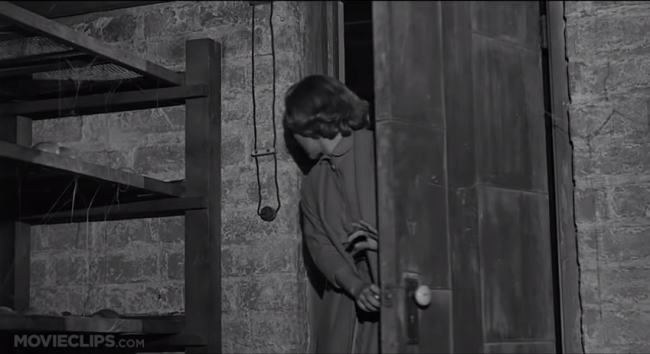Movement & Editing
The movie Psycho definitely relies on careful editing and special movements of the camera to portray the thrilling and suspenseful feelings to the viewer. Even with the movie being from the 1960s Alfred Hitchcock did a tremendous job of this especially in the climax scene of the movie. The scene where the viewer finds out the truth about the mother, Mrs. Bates. The scene is shown below.
The scene starts out with Lila coming down the stairs and the camera then enters a shot as if were in the mind of Lila looking out the window and we can see Norman Bates coming up to the house to find her. Lila then hurries down stairs as the camera follows it ends up stopping into a floor level, low angle shot on Norman Bates as he comes into the house. At this point the moving characters along with the camera angles are making the suspense. As Norman Bates runs upstairs the camera then follows Lila up the stairs then there is a cut scene as we look down onto the fruit cellar door from Lila’s eye level once again almost as if we, the viewer, are being put into Lila’s mind. Now at this point it is the camera movement that is creating the suspense as Lila realizes that Mrs. Bates is down in the cellar the camera follows Lila downstairs. Once Lila makes it to the door a low angle shot looking on to Lila a low angle shot keeps the suspense rising. After she makes it through the door once again we have almost the same tactic of building suspense. As Lila walks through the room the camera spins on an axis following Lila to the next door and after that the view is again put into a low angle shot as she walks through the next door. As she gets to the next door it is the character movement and camera angle and positioning that is creating the suspenseful mood. The camera and Lila both have our backs turned to what we are about to see as you can see below.
http://www.youtube.com/watch?v=xWHYmNrAFlI (0:46)
We then make a quick turn around and we get the first glimpse of Mrs. Bates. We are then turned back to Lila and we are taken backwards by the camera. We turn back around as we finally see the truth about Mrs. Bates as Lila spins her around in the chair. She screams and we are taken into a series of reaction shots as Norman Bates in his mother’s persona runs into the room. The reaction shots are between Lila and Norman Bates and then with Sam as he races in to save Lila. I think another thing to point out in this particular part of the scene is that the camera focuses in on the knife creating even more terror for the viewer. As Sam restrains Norman Bates and takes the knife away we start to get a feeling of relief but then we are taken back to a close up of Mrs. Bates putting back the terror into the climactic scene. The scene then ends with a mass of cars and people around the court house.
Understanding Movies Thirteenth Edition Louis Giannetti



